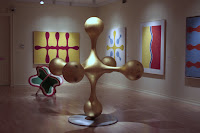
Welcome!
The Paul Feeley show opened last weekend at the BenningtonMuseum and has already gotten quite a good buzz!Please see the curator's (Jamie Franklin) piece on Feeley on their website under current special exhibitions.
http://www.benningtonmuseum.org/Historical info:
I recently came across this little old review of a show at the Betty Parson's Gallery:PAUL FEELEY ,Parsons, 24 West 57th."My own notion of art," claims Bennington Art Professor Feeley, "has to do with something that has presence but isn't unduly urgent, that brings you to it rather than projects itself upon you." His sensuous colors don't scream for attention, but they are thoroughly seductive once they get it. Fifteen works in plastic paint on unsized canvas. Through Nov. 21.
One way to guage Feeley's popularity is to see his influence on current contemporary artists,
http://www.artcal.net/event/view/1/6218 . Martin's paintings are investigations in color, formand texture, ranging from bold and graphic to gestural and expressionistic. Their surfaces are often distressed or collaged with elements including shellacked Wonder Bread, broken vinyl records and papier mache forms. Martin is deeply engaged withthe history of abstraction, and many of his own paintings incorporate homages to artistic influencessuch as Paul Feeley, Yayoi Kusama and Alfred Jensen. Martin has described his art as turning up the volume of painting and many of his works refer tomusicians including Miles Davis, John Coltrane and the Godfather of Soul: James Brown
PTF Signature Work Please see an image of one of Feeley's signatureworks. The National Gallery of Art in Washington D.C.owns one "edition" of the "Jack". Bennington College owns the other edition (currently on display at theBennington Museum).Paul Feeley believed that art was "the translation ofthree dimensions into two and of two into three." Jack is an abstract sculpture derived from Feeley's brightly colored paintings of undulating, symmetricalforms. It evokes a human figure standing on tiptoe andreaching out into all dimensions of space, like aballerina on point or a little girl flinging her armsout and twirling "just for the fun of it." The pointsand curves in the sculpture create new shapes from thespaces around them, making us see the room in a newway. Jack embodies Feeley's conviction that art shouldbe playful, imaginative, and accessible to people ofall ages. The sculptor hoped that his works wouldencourage viewers to "ease off" and take life lessseriously (Brockway, "Personalities of Painters in the'40s: Feeley, Knaths & Holt," Bennington Quadrille,February 1985).
Recent Blog references:
http://inbetweennoise.blogspot.com/search/label/paul%20feeleyalong with huxley, i saw a lot of paul feeley (whom matthew marks recently put back on artists' radars)and another british painter from the late 60's, robyndenny. i really wonder why it is that at this particular moment in time, the flat spare abstractionfrom the mid 60's and 70's has returned to painting,with, unfortunately, none of the substance, and all ofthe style.
http://danvera.typepad.com/bloggo/2007/09/poets-on-the-tr.htmlReaders of this blog know I've been on a Nemerov jagof late since discovering his collected poems on the Chesapeake a few weeks back. Finding this presentvoice speaking to me on this trip was a delight. Interestingly enough, the current owners of the RobertFrost house, have a framed piece in the entryway that's based largely on Nemerov's stunning "ThePainter Dreaming In The Scholar's House." So we had to read this poem written for Paul Klee and Paul Feeley aloud in its complete form. A few selections:
For such a man, art is an act of faith:
Prayer the study of it, as Blake says,
And praise the practice; nor does he
divide
Making from teaching, or from theory.
The three are one, and in his hours of art
There shines a happiness through darkest
themes,
As though spirit and sense were not at
odds.
and
That there should be much goodness in
the world,
Much kindness and intelligence, candor
and charm,
And that it all goes down in the dust
after a while,
This is a subject for the steadiest
meditations
Of the heart and mind, as for the tears
That clarify the eye toward charity.
So may it be to all of us, that at some
times
In this bad time when faith in study seems
to fail,
And when impatience in the street and
still despair at home
Divide the mind to rule it, there shall
some comfort come
From the remembrance of so deep and
clear a life as his.
Paul Feeley wrote this Bennington Art Policy for Bennington College in October, 1959. Having studied art at Bennington, I can now see why and how I was allowed to learn and grow in the way I did. This is great.


